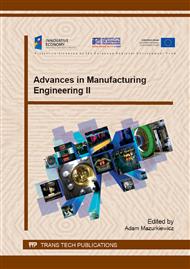[1]
J. Zhao, L.Q. Lu, The application of multi-wedge cross wedge rolling forming long shaft technology, Applied Mechanics and Materials. 101-102 (2011) 1002-1005.
DOI: 10.4028/www.scientific.net/amm.101-102.1002
Google Scholar
[2]
J. Tomczak, Z. Pater, T. Bulzak, Thermo-mechanical analysis of a lever preform forming from magnesium alloy AZ31, Archives of Metallurgy and Materials. 57 (2012) 1211-1218.
DOI: 10.2478/v10172-012-0135-z
Google Scholar
[3]
S. Urankar, M. Lovell, C. Morrow, Q. Li, K. Kawada, Establishment of failure conditions for the cross-wedge rolling of hollow shafts, Journal of Materials Processing Technology. 177 (2006) 545-549.
DOI: 10.1016/j.jmatprotec.2006.04.052
Google Scholar
[4]
J. Bartnicki, Z. Pater, Numerical simulation of three-rollers cross-wedge rolling of hollowed shaft, Journal of Materials Processing Technology. 164–165, (2005) 1154-1159.
DOI: 10.1016/j.jmatprotec.2005.02.120
Google Scholar
[5]
Z.H. Zheng, B.Y. Wang, Z.H. Hu, Study on roller profile for cam forming by cross wedge rolling, Applied Mechanics and Materials. 217-219 (2012) 1713-1718.
DOI: 10.4028/www.scientific.net/amm.217-219.1713
Google Scholar
[6]
Z. Pater, Cross-wedge rolling of shafts with an eccentric step, Journal of Iron and Steel Research International. 18, (2011) 26-30.
DOI: 10.1016/s1006-706x(11)60073-3
Google Scholar
[7]
J. Tomczak, Rotary compression process for producing toothed hollow shafts, Metalurgija. 53 (2014) 649- 652.
Google Scholar
[8]
J. Tomczak, Z. Pater, T. Bulzak, Designing of screw impressions in the helical rolling of balls, Archives of Civil and Mechanical Engineering. 14 (2014) 104-113.
DOI: 10.1016/j.acme.2013.07.004
Google Scholar
[9]
A. Tofil, Research of new splitting process of pipe billets from 2618A aluminium alloy basing on cross-wedge rolling, Archives of Metallurgy and Materials. 58 (2013) 725-729.
DOI: 10.2478/amm-2013-0061
Google Scholar
[10]
A. Tofil, Theoretical and experimental analysis of splitting process without waste of pipe billets from Ti6Al4V alloy, Steel Research International. Spec. Ed. (2012) 59-62.
Google Scholar
[11]
A. Tofil, Z. Pater, J. Tomczak, Polish Patent PL215512 B1 (2011).
Google Scholar
[12]
Z. Pater, E. Bogusz, A. Gontarz, W. Weroński, Polish Patent PL208033 B1 (2004).
Google Scholar
[13]
Z. Pater, A. Tofil, J. Tomczak, Steel balls forming by cross wedge rolling with upsetting, Metalurgija. 52 (2013) 103- 106.
DOI: 10.2478/amm-2013-0150
Google Scholar
[14]
Z. Pater, European Patent EP2540409 B1 (2011).
Google Scholar
[15]
Z. Pater, J. Tomczak, European Patent EP2422896A1 (2011).
Google Scholar
[16]
J. Tomczak, Z. Pater, European Patent EP2422897A1 (2011).
Google Scholar
[17]
Z. Pater, A. Gontarz, J. Tomczak, T. Bulzak, Producing hollow drive shafts by rotary compression, Archives of Civil and Mechanical Engineering, In Press, Corrected Proof, Available online 24 January (2015).
DOI: 10.1016/j.acme.2014.10.002
Google Scholar
[18]
J. Tomczak, T. Bulzak, Z. Pater, The effect of billet wall thickness on the rotary compression process for hollow parts, Strojniški vestnik – Journal of Mechanical Engineering. 61 (2015) 149-156.
DOI: 10.5545/sv-jme.2014.1977
Google Scholar
[19]
J. Tomczak, Z. Pater, T. Bulzak, Effect of technological parameters on the rotary compression process, Maintenance and Reliability. 15 (2013) 279–283.
Google Scholar
[20]
J. Tomczak, Z. Pater, T. Bulzak, Forming of hollow shaft forging from titanium alloy Ti6Al4V by means of rotary compression, Archives of Metallurgy and Materials. 60 (2015) 421-427.
DOI: 10.1515/amm-2015-0069
Google Scholar
[21]
T. Bulzak, J. Tomczak, Z. Pater, Theoretical and experimental research on forge rolling process of preforms from magnesium alloy AZ31, Archives of Metallurgy and Materials. 60 (2015) 439-445.
DOI: 10.1515/amm-2015-0072
Google Scholar


